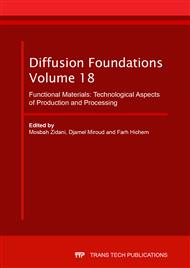[1]
B. Prinz and A. Romero, Immiscibe liquid metals and organics, ed L. Ratke, DGM Informationsgellschalt, p.244, (1993).
Google Scholar
[2]
O.V. Abramov, J.M. Semin, M.Z. Sorkin and J.Ju.Chashecking, Pys. Chem. Mater, Treatment, Vol 3, p.47,(1981).
Google Scholar
[3]
D. Uffelmann, L. Ratke and B. Feuerbecher, Immiscible liquid Metals and organics, ed L. Ratke, p.239, (1993).
Google Scholar
[4]
I.P. Akagwn , P.N. Quested, F. Brooks and Z. Fan, Proceedings of the eneerging doctorate en environmental technology, (2000).
Google Scholar
[5]
L. Ratke, S. Diefenbach, Materials Science and Engineering. Vol. R15 pp.263-347, (1995).
Google Scholar
[6]
Ratke L (ed), Immiscible Alloys and Organics, Oberursel: DGM-Informationsgesellschaft, (1993).
Google Scholar
[7]
B. Predel, L. Ratke and H. Frederikson, Fluid Sciences and Materials Science en space, ed H. U. Walter, Berlin springer, p.517, (1987).
Google Scholar
[8]
J. Reger, Interim Report NAS8-2867, NASA, Redondo Beach, ca.a.
Google Scholar
[9]
E. Pelzel, Metall, vol 10, p.1023, (1956).
Google Scholar
[10]
V.P. Vassiliev, V.A. Lysenko, Weiping Gong, Journal of alloys and compounds 564, pp.49-54, (2013).
Google Scholar
[11]
I. Rykowska, J. Ziemblinska, I. Nowak, Journal of molecular liquids, 259, pp.319-339, (2018).
Google Scholar
[12]
Aniruddha, M. Mandhare, Sung-H. Han, Mansing. A. Anuse, Sanjay. S. Kolekar, Arabian journal of chemistry, 18 pp.456-464, (2015).
Google Scholar
[13]
A.Munitz, M. J. Kaufman, R. Abbaschian, Intermetallics, 86, pp.59-72, (2017).
Google Scholar
[14]
H.R. Katadials, A. Das, E. Doernbery, R.Schmid- Fetzer, Materials chemistry and physics, 131, pp.241-249, (2011).
Google Scholar
[15]
L. Kaufman, H. Bernstein. Computer Calculation of the Phase Diagrams. Acadimic Press, New York. (1970).
Google Scholar
[16]
O.Redlich, A.T. Kister, Ind, EngChem, 40,345, (1948).
Google Scholar
[17]
A.T. Dinsdale. Calphad 15, 4 (1991) 317.
Google Scholar
[18]
T.B. Massalski, Binary Alloys Phase Diagrams, Metals Park, OH, American Society for Metals, (1990).
Google Scholar
[19]
Z. Zhaochun, S. Hang, W. Zhu, Ch. Nianyi and P. Ruiwvu, Calphad Vol. 22, No. 3, pp.313-322, (1998).
Google Scholar
[20]
Y. Plevachuk and V. Sklyarchuk, Journal of Molecular Liquids 105/2–3 (2003) 215–219.
Google Scholar


